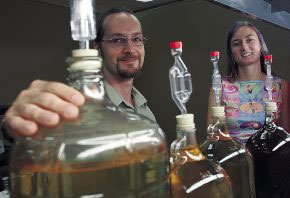 The National Alfalfa and Forage Alliance recently conducted its first Renewable Fuels Summit, “Bioenergy Systems: Alfalfa the Sleeping Giant,” in Washington D.C.
The National Alfalfa and Forage Alliance recently conducted its first Renewable Fuels Summit, “Bioenergy Systems: Alfalfa the Sleeping Giant,” in Washington D.C.
The August 8 event, which had more than 80 registered attendees, included presentations on cellulosic ethanol, alfalfa as a green biomass alternative, the role of corn-alfalfa rotation in bioenergy systems, and more. Speakers also focused on United States Department of Agriculture research and development, as well as legislative updates.
 NK Seeds, a business unit of Syngenta Seeds, Inc., was one of the event’s sponsors. Joe Waldo, NK alfalfa product manager with Syngenta Seeds said, “While many do not think of alfalfa as a potential source of fuel, the summit explored the role alfalfa can play in the biofuels industry, which is why we were proud to be an event sponsor.”
NK Seeds, a business unit of Syngenta Seeds, Inc., was one of the event’s sponsors. Joe Waldo, NK alfalfa product manager with Syngenta Seeds said, “While many do not think of alfalfa as a potential source of fuel, the summit explored the role alfalfa can play in the biofuels industry, which is why we were proud to be an event sponsor.”
Summit proceedings can be ordered from the NAFA website. There is also a good article on the topic in this month’s Ethanol Producer Magazine.


 According to the
According to the  The
The  The
The 
 In an effort to get back on the road, Shared Route… a colorful, biodiesel bus that runs between Portland, Oregon and Olympia and Seattle, Washington… will run on vegetable oil.
In an effort to get back on the road, Shared Route… a colorful, biodiesel bus that runs between Portland, Oregon and Olympia and Seattle, Washington… will run on vegetable oil. “I understand it’s an uphill battle, and I’m going to stay in the fight,” said ITAC Engineers & Constructors Senior Vice President Rick Starnes, a key player in the project who spent more than 20 hours last week walking Brentwood to discuss the plant with residents. “I wouldn’t work this hard if I didn’t think this was the right project for this area.”
“I understand it’s an uphill battle, and I’m going to stay in the fight,” said ITAC Engineers & Constructors Senior Vice President Rick Starnes, a key player in the project who spent more than 20 hours last week walking Brentwood to discuss the plant with residents. “I wouldn’t work this hard if I didn’t think this was the right project for this area.”

 The exective director of the
The exective director of the  Blume, who sounds like one pretty interesting character, is the author of a soon-to-be-released book called “Alcohol Can Be A Gas,” subtitled Fueling an Ethanol Revolution for the 21st Century.
Blume, who sounds like one pretty interesting character, is the author of a soon-to-be-released book called “Alcohol Can Be A Gas,” subtitled Fueling an Ethanol Revolution for the 21st Century.